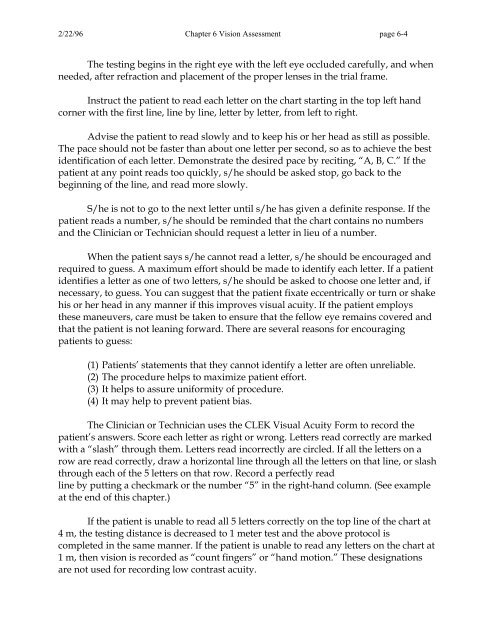OM t of c.iii - Vision Research Coordinating Center - Washington ...
OM t of c.iii - Vision Research Coordinating Center - Washington ...
OM t of c.iii - Vision Research Coordinating Center - Washington ...
Create successful ePaper yourself
Turn your PDF publications into a flip-book with our unique Google optimized e-Paper software.
2/22/96 Chapter 6 <strong>Vision</strong> Assessment page 6-4<br />
The testing begins in the right eye with the left eye occluded carefully, and when<br />
needed, after refraction and placement <strong>of</strong> the proper lenses in the trial frame.<br />
Instruct the patient to read each letter on the chart starting in the top left hand<br />
corner with the first line, line by line, letter by letter, from left to right.<br />
Advise the patient to read slowly and to keep his or her head as still as possible.<br />
The pace should not be faster than about one letter per second, so as to achieve the best<br />
identification <strong>of</strong> each letter. Demonstrate the desired pace by reciting, “A, B, C.” If the<br />
patient at any point reads too quickly, s/he should be asked stop, go back to the<br />
beginning <strong>of</strong> the line, and read more slowly.<br />
S/he is not to go to the next letter until s/he has given a definite response. If the<br />
patient reads a number, s/he should be reminded that the chart contains no numbers<br />
and the Clinician or Technician should request a letter in lieu <strong>of</strong> a number.<br />
When the patient says s/he cannot read a letter, s/he should be encouraged and<br />
required to guess. A maximum effort should be made to identify each letter. If a patient<br />
identifies a letter as one <strong>of</strong> two letters, s/he should be asked to choose one letter and, if<br />
necessary, to guess. You can suggest that the patient fixate eccentrically or turn or shake<br />
his or her head in any manner if this improves visual acuity. If the patient employs<br />
these maneuvers, care must be taken to ensure that the fellow eye remains covered and<br />
that the patient is not leaning forward. There are several reasons for encouraging<br />
patients to guess:<br />
(1) Patients’ statements that they cannot identify a letter are <strong>of</strong>ten unreliable.<br />
(2) The procedure helps to maximize patient effort.<br />
(3) It helps to assure uniformity <strong>of</strong> procedure.<br />
(4) It may help to prevent patient bias.<br />
The Clinician or Technician uses the CLEK Visual Acuity Form to record the<br />
patient’s answers. Score each letter as right or wrong. Letters read correctly are marked<br />
with a “slash” through them. Letters read incorrectly are circled. If all the letters on a<br />
row are read correctly, draw a horizontal line through all the letters on that line, or slash<br />
through each <strong>of</strong> the 5 letters on that row. Record a perfectly read<br />
line by putting a checkmark or the number “5” in the right-hand column. (See example<br />
at the end <strong>of</strong> this chapter.)<br />
If the patient is unable to read all 5 letters correctly on the top line <strong>of</strong> the chart at<br />
4 m, the testing distance is decreased to 1 meter test and the above protocol is<br />
completed in the same manner. If the patient is unable to read any letters on the chart at<br />
1 m, then vision is recorded as “count fingers” or “hand motion.” These designations<br />
are not used for recording low contrast acuity.
















